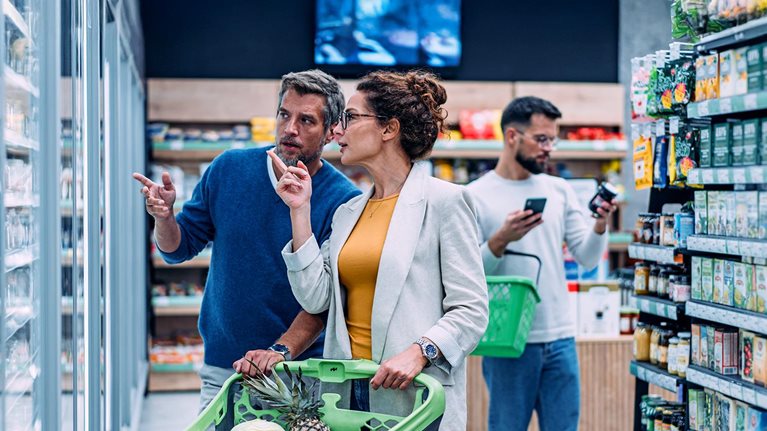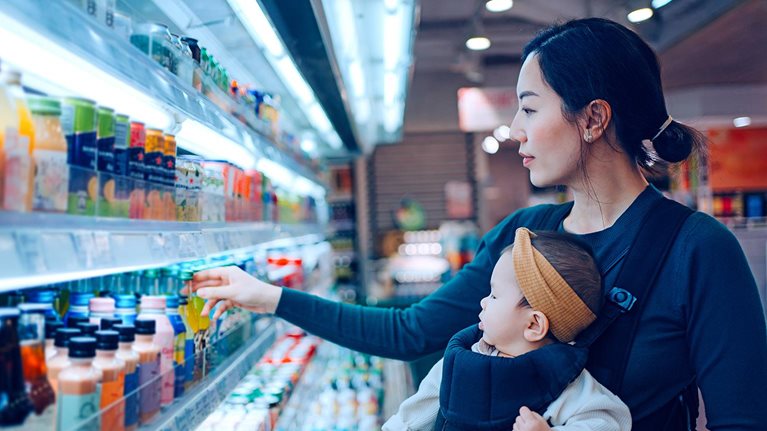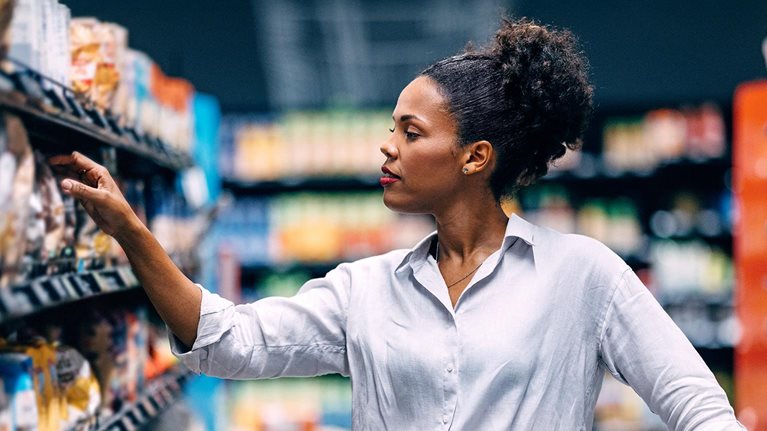Over the past decade, McKinsey has published more than 20 articles on the topic of packaging sustainability.1 These articles have been informed by the firm’s work with clients, extensive interviews with experts, and detailed primary research, including the following:
- Multiple global surveys. We have launched multiple global surveys to understand consumer sentiment, and we have published a variety of geographic deep dives based on that work.2
- Detailed regulatory mapping. We have examined and considered regulations in more than 30 countries across every major region to understand both market-specific developments and overarching trends.3
- Rigorous quantitative analysis. We have undertaken detailed primary research to understand whether including environmental, social, and governance (ESG) claims on product packaging can drive above-market growth (spoiler: The answer is yes).4
- Expert interviews. Over the years, we have interviewed representatives of hundreds of fast-moving consumer goods (FMCG) companies, retailers, producers of private-label goods, packaging converters, and co-packagers to understand barriers and opportunities.5
- A proprietary data set. We have developed a deep proprietary database of packaging performance indicators across substrates,6 which can be used to offer deep insights into packaging design.7
Our research and experience over the past decade have uniquely prepared us to understand how the topic of sustainability in packaging has evolved. Given ongoing inflationary pressures and economic uncertainty,8 as well as issues with destocking9 and falling demand,10 sustainable-packaging strategies that would have worked ten years ago may no longer be fit for purpose.
This article collects key high-level insights from across our recent body of work to help packaging converters understand and navigate the fast-moving landscape of sustainable packaging. These insights help inform strategic frameworks on where to play and how to win. Of course, one size does not fit all, and these frameworks need to be tailored based on end use, substrate, region, and customer group. Companies that are prepared to invest in developing and implementing these context-specific strategies will be well positioned to overcome challenges, meet regulatory requirements, and seize the opportunities inherent in sustainable-packaging leadership.
Five key shifts shaping sustainability in packaging today
Five key shifts have already begun to reshape the landscape of sustainable packaging and will likely persist in the coming years.
1. Sustainability requires complex trade-offs, with no single packaging substrate leading across dimensions
Our research indicates that there is no one-size-fits-all solution that converters can automatically implement as they work with FMCG and retailer customers on strategies for sustainable packaging.11 Over the years, sustainable-packaging efforts have often centered around three core areas:
- circularity, which includes efforts to increase recyclability and the use of recycled content
- leakage into the environment, which includes efforts to minimize harm from materials—particularly, but not only, single-use packaging—to the environment
- reducing greenhouse gas emissions across the value chain, which increasingly involves holistic efforts that consider the full life cycle
While these three core sustainability areas are interlinked, there can also be trade-offs between them for FMCGs and retailers. Increasing recyclability does not always decrease carbon footprints and food waste, for example. Individual assessments about the sustainability of individual packaging materials therefore vary according to which sustainability elements the assessor deems to be the priority.12
A related, important, factor for value chain participants to consider is that no single packaging substrate (for example, metal, plastic, glass, or paper) appears to have an advantage across every dimension of packaging sustainability. Each substrate has both positive and negative attributes that may vary by region and by application.13
2. Consumers may be placing relatively less weight on ESG factors in their purchasing decisions, though opinions and willingness to pay vary substantially
After a slight uptick between 2020 and 2023, the importance of environmental impact for consumers relative to other characteristics—such as price and shelf life—has either stagnated or declined since 2023. This factor now ranks among the bottom three characteristics across the 11 countries included in our global survey exploring consumers’ attitudes toward sustainable packaging.14
A significant share of consumers remain willing to pay at least a little more for sustainable packaging. At least 40 percent of consumers in all countries included in our 2023 survey stated they would pay more, including more than 70 percent of consumers in Mexico, Brazil, India, and China.15 However, the share of consumers who are willing to pay a lot more for sustainable packaging has been relatively small in all three of our survey rounds (2020, 2023, and 2025).16 Willingness to pay declined between 2020 and 2023 and has not rebounded to 2020 levels in many countries, likely influenced by ongoing cost pressures.17 Supporting this assessment, the importance of price has generally grown in importance over the surveyed period, solidifying its position—alongside perceptions of quality—as a top decision factor in purchasing.18
But consumer views are nuanced and often vary by demographics, geography, and the availability of local infrastructure. For example, consumers generally agree that recyclability is the most important factor, but views on the importance of reusability and overall CO2 impact vary substantially.19 In terms of preferred materials, respondents in the countries with the highest polyethylene terephthalate (PET) bottle collection rates—Germany, Sweden, and Japan, at 80 percent or more—ranked PET in their top three, whereas countries with the lowest collection rates (such as the United States, at 33 percent) ranked PET much lower.20
Moreover, consumer attitudes are not always strictly consistent and may depend on knowledge and understanding of recycling processes. Our 2025 global survey found, for example, that consumers ranked plastic packaging that is either recyclable or made from compostable materials as quite sustainable, but also deemed plastic containers and bottles made from such recycled materials to be among the least-sustainable options.21
3. The global regulatory landscape is becoming both more exacting and more complex
Understanding developing regulations on a global scale is complex, given highly varied regulatory maturity across countries—and even at the federal, state, or city level.22 Also, key terminology lacks an established global definition. The term “recycling,” for example, can have different meanings across countries and contexts,23 leading to potential challenges about inconsistent claims and variability in the impact of recycling-related initiatives.
In addition, the scope of seemingly similar regulations may vary.24 For example, some regulations are focused on multiple categories, applications, end products, and materials, while others have a much narrower focus, potentially leading to regulatory overlap. Further compounding these issues, some regulations—such as those related to reusable packaging targets—are still in the early stages of development, which may lead to uncertainty about undefined scopes, action plans, or targets.25
4. Packaging purchasers are committed but face large barriers to implementing sustainable packaging at significant scale
Until now, actions by retailers and FMCG companies have focused primarily on quick wins—such as reducing material usage and weight—that also enable them to lower their packaging costs. However, over recent years these companies have been proactively making ambitious commitments to improve the sustainability of their packaging, as well as to fundamentally rethink their packaging systems.26
Despite this momentum, adoption of sustainable-packaging materials has been slow. Based on extensive interviews with experts and primary research, we have identified six key barriers to widespread adoption of sustainable-packaging material.27 As discussed above, lack of alignment and lack of clarity account for two of those barriers. The others focus on affordability, performance, the supply of materials, and an incomplete knowledge of available solutions.
- Affordability. Sustainable materials often have a higher price tag. To maintain product margins, companies generally have to pass costs on to consumers—which can be challenging. Success requires packaging solutions to combine cost-efficiency with the highest standards of customer convenience, such as easy-opening products and packaging designed for on-the-go consumption.28
- Performance. It can be challenging to find sustainable alternatives that can match the performance of traditional materials. Retailers and e-commerce retailers can have additional concerns about the performance of sustainable products during transportation, storage, and shelving.
- Limited or unreliable supply. Sustainable materials may not always be available in the consistent quality or volumes required, which inhibits their uptake. Our research identified a number of real-world examples of the impact of these supply risks on the go-to-market strategy of incumbents in relation to sustainability.
- Incomplete knowledge of existing and developing solutions. Many packaging purchasers say that they don’t have full knowledge of the sustainable-packaging options available to them. New innovations become available regularly, and interviewees indicated that gathering all the relevant data on possible packaging options—including performance, sustainability credentials, and the likely evolution of cost, supply, and relevant regulations—can be cumbersome and time-consuming. As a result, several of our interviewees said they continue to rely mostly on existing solutions or suppliers.
5. Other consumer industry megatrends are having a significant impact on packaging, though details vary by region
Sustainability is not the only trend affecting the packaging industry. Other megatrends—including the shift to e-commerce, rapidly changing consumer preferences (including high price sensitivity), increased focus on health and wellness, and embracing digital (especially gen AI)—are here to stay, though the impact of these trends and the direction of their evolution can vary significantly by region.29 E-commerce, in particular, has been a key growth driver in packaging over the past five to ten years, with several categories on the brink of reaching a volume-related tipping point at which packaging will need to be redesigned to specifically match the need of digital channels.
One thing remains constant across geographies and time: Low cost and high convenience continue to be table stakes for packaging, even if consumers’ expectations for packaging may shift.
Winning in sustainable packaging: Where to play and how to win
Systematic and comprehensive efforts will be needed to meaningfully advance the sustainability agenda. For example, companies will need to consider the sustainability of a product’s packaging before the product concept has been finalized—which, in our experience, is not always the case today—in order to maximize their options for effective action to increase sustainability. For holistic impact, future efforts will need to cover everything from input materials to marketing to after-sales responsibilities, while carefully managing costs along the value chain.
The fundamental success principle is to invest where it matters.
Putting that principle into practice, however, will be difficult. As we see from above, there are complexities and trade-offs to consider—many of which will be context specific—which means there is no one-size-fits-all solution. Instead, packaging converters will have to collaborate with their FMCG and retailer customers as well as with consumers to find innovative solutions and processes.
Two strategic frameworks—“where to play” and “how to win”—can provide a useful starting point.
Where to play
The aspects of sustainability that matter—and the amount they matter—will vary by end product and consumer segment. To win, packaging players will need to develop a granular understanding of demand and willingness to pay. Developing this understanding will likely require a full strategic assessment of consumer sentiment and the value at stake as well as a forward-looking assessment of possible innovations in the sustainability space, the likely evolution in supply and demand of key materials, and possible regulatory developments.
At the same time, our survey results have made clear that sustainability efforts should not come at the expense of factors that many consumers may deem more important, including durability, food safety, shelf life, or convenience.
A good way to build momentum by registering early success can be to identify no-regret moves. For example, one promising area could be product segments that offer low barriers to switching to a more-sustainable packaging substrate and where most of the work can be done by the individual FMCG company and converter, without the need for coordination across the broader value chain. Promising opportunities will typically exist within product segments where the required actions will have minimal impact on functionality, operating cost or capital expenditure needs, or the attractiveness of the packaging.30
How to win
Our experience with leading incumbents suggests that success in the sustainable-packaging space will hinge on the existence of clear commercial, operational, and technology road maps—as well as an integrated and well-sequenced execution approach.
- Align internally on what ‘good’ looks like. Put together a clear methodology on how to uniquely benchmark packaging products in terms of sustainability, cost, and convenience—and ensure that all core teams are aligned around this framework.
- Formulate clear operational and technology road maps to ensure a robust innovation pipeline. Most sustainable-packaging materials continue to be constantly refined, with successive generations offering better performance and lower cost. The continuation of this innovation process will be key to securing the large-scale adoption of these materials. Given the challenges involved in R&D, players will require a clear and thoughtful innovation road map that takes into account possible trade-offs between sustainability goals. Companies that decide to direct a high portion of their innovation spend toward increasing recyclability, for example, should be aware of the possible impact on customer food waste—while multilayer film increases shelf life, for instance, it has historically been hard to recycle.
- Be clear and consistent in messaging and sales strategy. Most commercial organizations within the packaging industry are comfortable with selling based on cost and technical areas such as barrier performance. Marketing and sales strategies related to sustainable packaging (which may be more expensive than alternatives, and which may have altered other packaging characteristics in its implementation) may require a different approach. To succeed, sales organizations will need to shift from transaction-based selling to become true value chain partners, working directly with customers to identify their complex needs and provide solutions. This shift may require capacity building to bolster salesforce effectiveness.
- Take an ecosystem approach. It is likely that no one single player in the packaging value chain will be able to understand and navigate all of the evolving complexities around consumer preferences, regulatory requirements, and fast-evolving technologies. Packaging converters should therefore also strengthen collaborations across the value chain—from input suppliers to end users—to strengthen both strategic planning and execution. Players should also regularly consider whether a reallocation of resources—or strategic M&A—could assist in scaling solutions or bolstering global reach.
- To start, go after the low-hanging fruit. It can be helpful to have a lighthouse project that provides a long-term organizational goal related to sustainable-packaging development. However, given all the complexities involved in this fast-evolving area and the need to build momentum, we recommend taking an incremental approach to reach that longer-term goal. In addition to enabling relatively rapid iterations, an incremental development approach can make it easier to ensure the continued high performance of chosen packaging types and to avoid excessive strain on other parts of the process, such as filling systems. Gradual changes can also make it easier to bring consumers along on the sustainability journey.
Sustainability in packaging is both a key industry-shaping trend for the whole packaging value chain and a rapidly evolving area. To stay ahead of the game, packaging players should pursue a policy of strategic urgency. They can start by formulating clear, context-specific strategies on both where to play and how to win.






